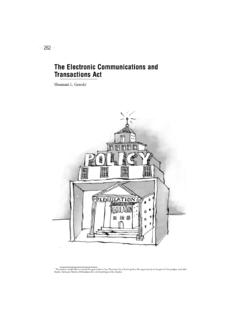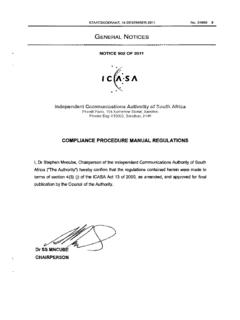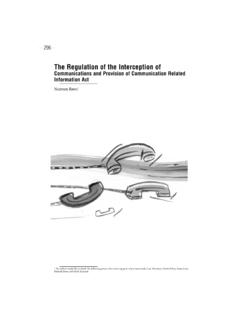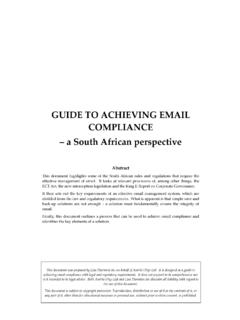Transcription of 3FQPSU PG UIF - Thornton
1 3 FQPSU PG UIF *$/ 8 PSLJOH (SPVQ . PO 5 FMFDPNNVOJDBUJPOT 4 FSWJDFT . "11&/%*9 ** . $PVOUSZ 4 UVEJFT . +BNBJDB 4 PVUI "GSJDB 5 BJXBO BOE 5 VSLFZ.. 87. APPENDIX III. Country Studies ( jamaica , South Africa, Taiwan, and Turkey). jamaica , South Africa, Taiwan, and Turkey offered to provide information on the state of competition in their respective telecommunications services markets. Also included in this appendix is the questionnaire sent to these countries, and both their initial and follow-up responses. The State of Competition in the Telecommunications Sector in jamaica 1. The State of Competition In the Telecommunications Sector (a) Telecommunications deregulation (i) Which segments of the market are deregulated and to what extent?)
2 The telecommunications sector is fully liberalised, however only three segments of the sector are fully deregulated. These are: international retail services (fixed and mobile); mobile domestic retail services, mobile termination; and Internet services. A review of the mobile termination market was recently conducted with a view to re-introducing regulation in that segment. For how long have these segments been deregulated? All the segments mentioned above except for international retail services have been deregulated since April 2000. International services were deregulated in March 2003.
3 What deregulation processes and strategies have been utilized? Who makes the deregulation decision? The Telecommunications Act (TA) mandates the Telecommunications Regulator (TR), to conduct market reviews, in consultation with the Competition Authority (CA), to determine which segments are sufficiently competitive and can be deregulated. The TA also gives the Minister the authority to order the Telecommunications regulator to forbear from regulating a segment of the sector. What was the role of the competition authority ( CA ) or competition principles in the deregulation process? The CA participated in the debates which preceded the liberalization of the sector.
4 (ii) What segments have not yet been deregulated? 88. Fixed network access and all related services excluding international calls. (b) Please describe any other competitive reforms that have taken place? No other competitive reform has taken place since liberalization. How has the CA or the use of competition principles facilitated such reforms? N/A. (c) Who is the incumbent telecommunications services provider and who are its main competitors? The incumbent operator is Cable and Wireless ( jamaica ) Limited. Its main competitors are: Digicel and Oceanic Digital in the mobile market and InfoChannel in the Internet market.
5 (d) What are the current market shares (incumbent and competitors) in each of the various telecommunications markets? The figures we have in-house were received under confidential cover. In which markets are the competitors most prominent? The mobile market. Where do barriers to entry still exist? The cost of bandwidth is likely to act as an entry barrier in those segments where it is an essential input. Service-based operators have identified exclusionary behaviour on the part of the incumbent as an entry barrier. The incumbent is still a monopolist provider of fixed network facilities and services.
6 How is the mitigation of such barriers to entry being resolved? 89. Rate-rebalancing is being carried out in the sector. Local rates have increased since liberalization while international rates have fallen. Internet rates have also fallen. (g) What are the general cost trends in the various markets? Cost is trending downwards in all markets. (h) Has the quality of service changed in telecommunications markets? If so, in what way? The quality of service has improved in both the Internet and mobile segments. In the case of fixed and Internet services they are now more reliable. In the case of mobile the number of dropped calls has been significantly reduced.
7 (i) Have new technologies been introduced in these markets? If so, what are the general competitive trends with respect to the introduction of new technologies? We are not aware of any new technology being introduced. How has such technology induced competition manifested itself? N/A. How have the CA and competition principles played a role in responding to such technology induced competition? N/A. 2. Governance In The Telecommunications Sector (a) Describe the specific roles of the CA and TR in the telecommunications sector? Under the TA the TR is mandated to promote and protect the interest of the public by: i.
8 Promoting fair and open competition in the provision of specified services and telecommunications equipment;. ii. promoting access to specified services;. 90. iii. ensuring that services are provided to persons able to meet the financial and technical obligations in relation to those services;. iv. providing for the protection of customers;. v. promoting the interests of customers, purchasers and other users (including, in particular, the disabled or the elderly) in respect of the quality and variety of telecommunications services and equipment supplied;. vi. to promote universal access to telecommunications services for all persons in jamaica , to the extent that it is reasonably practicable to provide such access; c) to facilitate the achievement of the objects referred to in paragraphs (a) and (b).
9 In a manner consistent with jamaica 's international commitments in relation to the liberalization of telecommunications; and vii. to promote the telecommunications industry in jamaica by encouraging economically efficient investment in, and use of, infrastructure to provide specified services in jamaica . In carrying out its mandate the TR sets price-caps; assesses Reference Interconnection Offers and Interconnection agreements; develops rules in accordance with the TA. Based on its mandate under the FCA the CA provides for the maintenance and encouragement of competition in the telecommunications sector.
10 The FTC. carries out its mandate by investigating anticompetitive behaviour in the sector; assessing proposed rules and regulations for anti-competitive effects and conducting sector inquiries. Does the CA only maintain competition, or does it also promote it? It also promotes competition. (b) Are competition law principles utilized or imputed into the TR's analyses and procedures? If so, how? Yes. In making a determination of dominance the TA mandates that the TR. utilize the principles established under the FCA. (c) Is the TR mandated to forbear from the regulation of specific services or markets?









